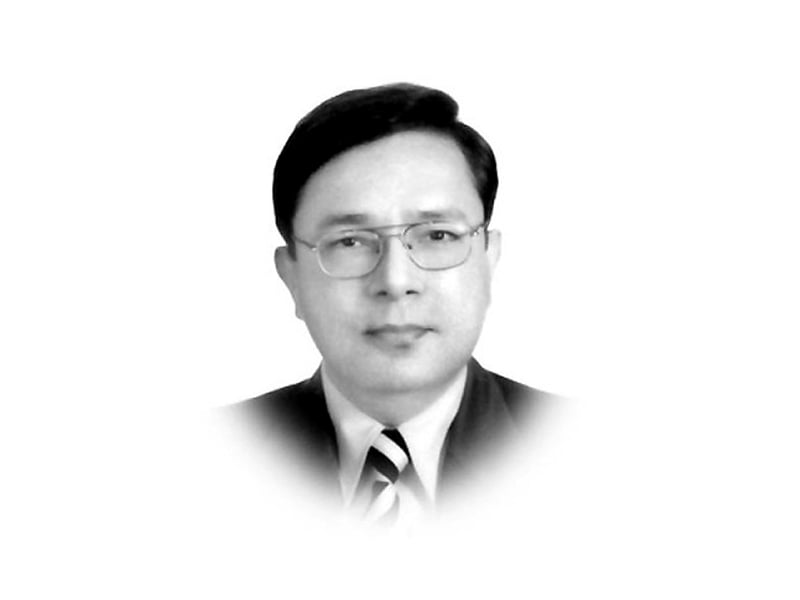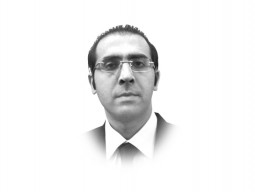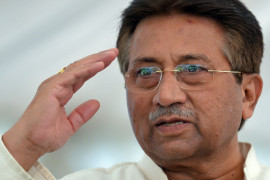
A dominant theory in judicial politics and law, “transitional justice” explains the role of the judiciary during the period of ‘transition’ in nascent democracies like Pakistan. Political and legal scholars define two kinds of transitional justice theories. The first kind is linked to the trials of world leaders involved in war crimes by the international or regional courts. After World War II, the trials of the leaders of Germany, Japan and Italy are the best examples. The second kind of transitional justice relates to national level trials of leaders or dictators of past regimes by democratic governments on accounts of constitutional and human rights violations. The echo of recent trials against former military dictator General (retd) Pervez Musharraf falls under the second type of transitional justice. In addition, there are two major schools regarding the application of transitional justice at the national level: a) truth vs justice and, b) democracy vs justice.
As far as the first assumption is concerned, i.e., truth vs justice, its supporters argue that it is necessary to punish the guilty in order to avoid abuses in the future. It is also essential for the courts to undermine impunity and invalidity, maintaining rule of law, restoring order in society and restoring the dignity of the victims. On the other hand, the proponents of democracy vs justice theory argue that democracy cannot be consolidated without burying the past. The focus should be on institutional reforms to strengthen democracy rather than political oppression, vendetta or making scapegoats. They also claim that transitional democracies are generally not in a position to hold accountable the dictators and other beneficiaries of the past regime. It is very important for a transitioning democracy to move forward because the accountability of the adherents of a past regime is, in all likelihood, bound to backfire on the ongoing democratic process. The establishment of the Truth and Reconciliation Commission (TRC) in South Africa after the apartheid era is the best example of the democracy vs justice argument.
There are a number of examples in history of ex-dictators having to face courts under new democratic governments. The analyses, arrayed from the data of over 100 transitioning democracies from 1980 to 2004, indicate that in the most cases — almost over 70 per cent — the ex-dictators faced prosecution. The former dictators of Haiti, Chili, Argentina, Guatemala, Cambodia, Uruguay, Egypt, Turkey, and Bangladesh are a few of them. However, the time factor is very important regarding the litigations against the ex-dictators. Most dictators were in the courts after over a period of a decade or more. In other words, the dictators faced the courts after the consolidation of democratic governments in those countries. And only those nations emerged as consolidated democracies which followed the path of democracy vs justice, as unwittingly put forth by Chaudhary Shujaat Hussain’s mitti pao.
The supporters of the first argument, i.e., truth vs justice in Pakistan, who are interested in starting prosecutions against General Musharraf in the Benazir Bhutto and Akbar Bugti murder cases, or the Lal Masjid incident, or implementation of Article 6, etc. know little about history and these theories. General Pervez Musharraf’s coming to Pakistan is a “foreshock” before a major political seismic activity is unleashed, and it could be a huge jolt to the whole political system if necessary care is not taken. It is also evident that some transitioning democracies went back and forth between civilian governments and military dictatorships. Any attempt to belittle or humiliate the former army chief will certainly provoke the powerful armed forces. It is the wrong time for the right thing. Wait for the right time.
Nevertheless, it is never too late to execute a dictator when democratic institutions are strong and enjoy the full support of the people. On January 30, 1661, the one and only military dictator of Great Britain, General Oliver Cromwell, was subjected to the symbolic ritual of a “posthumous execution” after his body was exhumed from Westminster Abbey. The British people displayed his severed head on a pole outside Westminster Hall and left it there for nearly a quarter of a century. Hence, it is only advisable to execute a dictator when you aren’t spineless or impotent.
Published in The Express Tribune, April 16th, 2013.
COMMENTS (12)
Comments are moderated and generally will be posted if they are on-topic and not abusive.
For more information, please see our Comments FAQ





















































@Abid P. Khan: You must be naive to think that Musharaf was accorded full honours at his abdication, the ceremonial farewell was directed towards the Office of the President and not the person per say. He lost his honour and that of the country when he caved in to the threats the foreign power in his house. He sneaked out before appearing in the court and sneaked in before being arrested to answer the charges in the court. His collaborators managed to obtain the bail before arrest. I know that my English is not very good but your understanding of sneak in and sneak out is very poor indeed. The rest of your rhetoric is a diversion.
Rex Minor
wel done sir your articles are a good source of knowledge for us
@Rex Minor: "...ex President of the country, who conveniently sneaked out of the country and after several years of absence has sneaked back into the country ...." . Being a German(?) may provide you with an excuse for not being acquainted with the Pakistani media. For your information Mr Musharraf, was accorded full honours at his abdication from power. . Pervez Musharraf stayed on for about half an year after he relinquished from his post and did not sneak out of the country as you may have done. Please, do not spread falsities, you will eventually be exposed one day, if you are working for someone.
Let me make two points:The society in Pakistan has different values and traditions than that of GB.In that country democracy has evolved over centuries,here it has been imposed by GB over less than 80years ago.Many still believes it to be an alien system and their manifestos say it explicitly.Here for political leadership democracy only means change of government through electoral process and there the democracy begins and ends. It means that the system is still evolving and may take half or more century to mature. Here,the 'terrorists' are already doing ' posthumous execution', of saints buried centuries ago and during funerals of unliked personalities.In Pakistan such a trend will lead to a different set of consequences than in GB or elsewhere.Use of it as a political tool is likely to be fatal.Secondly,in Pakistan,the civil bureaucracy or military take overs unlike from other countries have taken a pseudo legal approach and all such actions were got legitamised through the Highest Court.Even November 3,act of imposing emergency was legitamised by the then SC. Any attempt to initiate proceedings under Article 6 against Musharraf will be illegal.Article 264 of the present constitution explicitly forbids any such action.If one blindly goes ahead with it,half would consider it legal,the second half would consider it illegal.Better not to do acts with catastrophic and monumental consequences for Pakistan.
Very good Op-Ed. Thanks ET.
Well done Sir, Hope you are doing well in making people understand what is transitional justice? I am sure it is a source of great learning for people like me.
The writer says any attempt to belittle or humiliate the former army chief will certainly provoke the powerful army. No army of today is different from army of yesteryears. Now the pople know that military adventures touted as victories were if anything stalemates. Even mil dictators got their acts indemnified by civ parliament. There should be a trial of Musharraf and those who indemnified his acts, caricatured the constitituon by including his name in Const'n, or allowed him to be a president in uniform. This exercise is better held today than in invisible tomorrow.
Many thanks for the history lesson Sir. Please widen your view to add the performances and corruption by the Pakistani Democracy. The word democracy has been so thoroughly prostituted in Pakistan that a wide majority (the poor commoners) do not even want to listen to it. Our irony is that whenever pseudo intellectuals compare Dictatorships here, they do so with the Democracies of the west. Not Applicable Sir. That is lopsided.
There is never the right time for the right thing to do!
Sorry Mr Khan, while your article narrates histoy , none of the entioned incidents are applicable to the situation in Pakistan with regard to the retired General, ex military administrator and ex President of the country, who conveniently sneaked out of the country and after several years of absence has sneaked back into the country with the pre- announcement that he now wants to go the democratic way to participate in the elections!
The paragraph of your article with regard to the timing is the most appropriate one, never mind about the provocaton of the powerful military, it is Musharaf who has brought shame on the military institution which is unparallel in world hisory as well as in Pakistan history.!.
How do you propose si, the Judiciary be asked to slow down its legal system in a county of law which was on hold until now due to the accused on vacation abroad,? Because of the timing? And when sir in your opinion is the right time to do the right thing?
Rex Minor
@Ricky: I agree with you sir. A pragmatic Op Ed by the ET, thanks for that. I guess for the sake of democracy we would have to control our emotions and not play in the hands of the deep state. We do not need to provide excuses to the generals to once again subvert the constitution for their egos.
This is an intriguingly interesting Op Ed that should be carefully read. It is true that the deep state is still as strong as during Mush’s prime and would not hesitate to use its strategic assets and resources with another Bonaparte act. Even though it makes sense to take the culprit to task and put him where he belongs but his coming back could be a calculated step and let us not fall in that trap. First the tsunami came then Qadri hit us, now Mush comes back even though everybody knows he has no political presence. I would go for cementing the democracy first, have a stable coalition of national govt and then follow the UK example. Once we put old grandfathers and fathers on trial it would be a lesson for coming generation. We don’t want a country where Gen Ayub, Gen Zia, and Gen Mush and their family members continue to act as the pillars of the country.